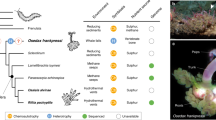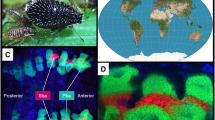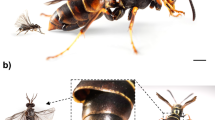Abstract
Many insects that rely on a single food source throughout their developmental cycle harbor beneficial microbes that provide nutrients absent from their restricted diet. Tsetse flies, the vectors of African trypanosomes, feed exclusively on blood and rely on one such intracellular microbe for nutritional provisioning and fecundity. As a result of co-evolution with hosts over millions of years, these mutualists have lost the ability to survive outside the sheltered environment of their host insect cells. We present the complete annotated genome of Wigglesworthia glossinidia brevipalpis, which is composed of one chromosome of 697,724 base pairs (bp) and one small plasmid, called pWig1, of 5,200 bp. Genes involved in the biosynthesis of vitamin metabolites, apparently essential for host nutrition and fecundity, have been retained. Unexpectedly, this obligate's genome bears hallmarks of both parasitic and free-living microbes, and the gene encoding the important regulatory protein DnaA is absent.
This is a preview of subscription content, access via your institution
Access options
Subscribe to this journal
Receive 12 print issues and online access
$259.00 per year
only $21.58 per issue
Buy this article
- Purchase on SpringerLink
- Instant access to full article PDF
Prices may be subject to local taxes which are calculated during checkout




Similar content being viewed by others
References
Moran, N.A. & Baumann, P. Endosymbionts in animals. Curr. Opin. Microbiol. 3, 270–275 (2000).
Aksoy, S. Tsetse: a haven for microorganisms. Parasitol. Today 16, 114–119 (2000).
Nogge, G. Sterility in tsetse flies (Glossina morsitans Westwood) caused by loss of symbionts. Experientia 32, 995–996 (1976).
Hill, P.D.S. & Campbell, J.A. The production of symbiont-free Glossina morsitans and an associated loss of female fertility. Trans. R. Soc. Trop. Med. Hyg. 67, 727–728 (1973).
Nogge, G. Significance of symbionts for the maintenance of an optional nutritional state for successful reproduction in hematophagous arthropods. Parasitology 82, 101–104 (1981).
Aksoy, S. Molecular analysis of the endosymbionts of tsetse flies: 16S rDNA locus and over-expression of a chaperonin. Insect Mol. Biol. 4, 23–29 (1995).
Chen, X., Song, L. & Aksoy, S. Concordant evolution of a symbiont with its host insect species: Molecular phylogeny of genus Glossina and its bacteriome-associated endosymbiont, Wigglesworthia glossinidia. J. Mol. Evol. 48, 49–58 (1999).
Akman, L. & Aksoy, S. A novel application of gene arrays: Escherichia coli array provides insight into the biology of the obligate endosymbiont of tsetse flies. Proc. Natl Acad. Sci. USA 98, 7546–7551 (2001).
Charles, H. & Ishikawa, H. Physical and genetic map of the genome of Buchnera, the primary endosymbiont of the pea aphid Acrythosiphon pisum. J. Mol. Evol. 48, 142–150 (1999).
Shigenobu, S., Watanabe, H., Hattori, M., Sakaki, Y. & Ishikawa, H. Genome sequence of the endocellular bacterial symbiont of aphids Buchnera sp. APS. Nature 407, 81–86 (2000).
Fraser, C. et al. The minimal gene complement of Mycoplasma genitalium. Science 270, 397–403 (1995).
Moran, N.A. Accelerated evolution and Muller's ratchet in endosymbiotic bacteria. Proc. Natl Acad. Sci. USA 93, 2873–2878 (1996).
Asai, T. & Kogoma, T. The RecF pathway of homologous recombination can mediate the initiation of DNA damage-inducible replication of the Escherichia coli chromosome. J. Bacteriol. 176, 7113–7114 (1994).
Douglas, A. Nutritional interactions between Myzus persicae and its symbionts. in Aphid-plant Genotype Interactions (eds Campbell, R. & Eikenbary, R.) 319–327 (Elsevier Biomedical, Amsterdam, the Netherlands, 1990).
Douglas, A.E. & Prosser, W.A. Synthesis of the essential amino acid tryptophan in the pea aphid (Acyrthosiphon pisum) symbiosis. J. Insect Physiol. 38, 565–568 (1992).
Ma, W.-C. & Denlinger, D.L. Secretory discharge and microflora of milk gland in tsetse flies. Nature 247, 301–303 (1974).
Cheng, Q. & Aksoy, S. Tissue tropism, transmission and expression of foreign genes in vivo in midgut symbionts of tsetse flies. Insect Mol. Biol. 8, 125–132 (1999).
Kubori, T. et al. Supramolecular structure of the Salmonella typhimurium type III protein secretion system. Science 280, 602–605 (1998).
Young, G.M., Schmiel, D.H. & Miller, V.L. A new pathway for the secretion of virulence factors by bacteria: the flagellar export apparatus functions as a protein-secretion system. Proc. Natl Acad. Sci. USA 96, 6456–6461 (1999).
Andersson, S.G. et al. The genome sequence of Rickettsia prowazekii and the origin of mitochondria. Nature 396, 133–140 (1998).
Moloo, S.K. An artificial feeding technique for Glossina. Parasitology 63, 507–512 (1971).
Sambrook, J. & Russell, D.W. Molecular Cloning: A Laboratory Manual (Cold Spring Harbor Press, Cold Spring Harbor, New York, 2001).
O'Neill, S.L., Gooding, R.H. & Aksoy, S. Phylogenetically distant symbiotic microorganisms reside in Glossina midgut and ovary tissues. Med. Vet. Entomol. 7, 377–383 (1993).
Fleischmann, R.D. et al. Whole-genome random sequencing and assembly of Haemophilus influenzae Rd. Science 269, 496–512 (1995).
Delcher, A.L., Harmon, D., Kasif, S., White, O. & Salzberg, S.L. Improved microbial gene identification with GLIMMER. Nucleic Acids Res. 27, 4636–4641 (1999).
Watanabe, H., Mori, H., Itoh, T. & Gojobori, T. Genome plasticity as a paradigm of eubacteria evolution. J. Mol. Evol. 44, S57–S64 (1997).
Tomb, J.F. et al. The complete genome sequence of the gastric pathogen Helicobacter pylori. Nature 388, 539–547 (1997).
Ogata, H. et al. KEGG: Kyoto Encyclopedia of Genes and Genomes. Nucleic Acids Res. 27, 29–34 (1999).
Kawagishi, I., Muller, V., Williams, A.W., Irikura, V.M. & Macnab, R.M. Subdivision of flagellar region III of the Escherichia coli and Salmonella typhimurium chromosomes and identification of two additional flagellar genes. J. Gen. Microbiol. 138, 1051–1065 (1992).
Ochman, H. & Groisman, E.A. The origin and evolution of species differences in Escherichia coli and Salmonella typhimurium. EXS 69, 479–493 (1994).
Acknowledgements
We would like to thank K. Furuya and C. Yoshino for their technical assistance; I. Kasumba for maintenance of the tsetse colonies; and the members of the Seibersdorf Agricultural Research laboratory, Austria, for their assistance with tsetse pupae. We also thank R.V.M. Rio, D. Nayduch and P. Strickler for their comments and editorial suggestions. This work was supported in part by the Research for the Future Program from the Japanese Society for the Promotion of Science to M.H., the US National Institutes of Health/Nation Institute of Allergy and Infectious Diseases to S.A. and Grant-in-Aid for Scientific Research on Priority Area (C) “Genome Science” from the Ministry of Education, Culture, Sports, Science and Technology of Japan to H.W.
Author information
Authors and Affiliations
Corresponding authors
Ethics declarations
Competing interests
The authors declare no competing financial interests.
Rights and permissions
About this article
Cite this article
Akman, L., Yamashita, A., Watanabe, H. et al. Genome sequence of the endocellular obligate symbiont of tsetse flies, Wigglesworthia glossinidia. Nat Genet 32, 402–407 (2002). https://doi.org/10.1038/ng986
Received:
Accepted:
Published:
Issue date:
DOI: https://doi.org/10.1038/ng986
This article is cited by
-
Symbioses shape feeding niches and diversification across insects
Nature Ecology & Evolution (2023)
-
Bacterial symbionts support larval sap feeding and adult folivory in (semi-)aquatic reed beetles
Nature Communications (2020)
-
Bacterial endosymbionts of Placobdella (Annelida: Hirudinea: Glossiphoniidae): phylogeny, genetic distance, and vertical transmission
Hydrobiologia (2020)
-
Genome expansion of an obligate parthenogenesis-associated Wolbachia poses an exception to the symbiont reduction model
BMC Genomics (2019)
-
Molecular characterization, ultrastructure, and transovarial transmission of Tremblaya phenacola in six mealybugs of the Phenacoccinae subfamily (Insecta, Hemiptera, Coccomorpha)
Protoplasma (2019)



